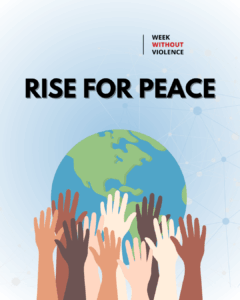Each year during the third week of October, Canadians and people around the world to mark YWCA’s Week Without Violence. This week focuses on raising awareness, promoting attitude change, and enabling individuals and organizations to begin positive actions towards ending violence in their communities.
Family violence is best understood as one or more persons’ attempt to control, dominate, and/or humiliate another through a variety of means, including physical, verbal, emotional, financial, and sexual abuse. It also includes neglect, stalking, being kept from seeing other people, and/or being forced to stay in one place, as well as threats to harm children, other family members, pets, and property. Family violence goes beyond individual acts of aggression to encompass an overall pattern of behaviour aimed at maintaining complete control. Family violence typically escalates in both frequency and severity over time. Without intervention, these behaviours may grow into a habitual method of resolving conflicts.
When most people think of domestic/family violence, they imagine a situation where the abusive partner physically hurts the victim. But of the types of domestic violence, physical abuse is only one form of abuse. Types of abuse include, but are not limited to:
- Psychological/Emotional (ex. blaming, humiliating insults or gestures, jealous and possessive, using children or pets to gain compliance or to manipulate, subtle threats, threatening suicide or self-harm)
- Physical (ex. hitting, strangling/choking, damages personal property, assault/threats involving a weapon, harming pets)
- Financial/Economic (ex. maintains complete control of money or ability to make money)
- Sexual (ex. feels pressured into engaging in sexual acts with the individual or others)
- Spiritual and/or Cultural (ex. denies spiritual or cultural practices, forces them to engage in a behaviour contrary to their beliefs)
- Isolation (ex. Preventing individual from see friends and/or relatives, forcing them to quit/leave work, monitoring phone calls, tracking whereabouts)
- Stalking (ex. follows individual to and from work, has other people monitor them, plants listening devices on individual or car; sending unwanted gifts or cryptic messages to work, home or others)
It can be really worrying when someone you care about is being hurt or abused by their partner. It can also be hard to know what to say or do.
- Do not judge them. Each person’s circumstance and experiences are unique. Respect their reasons for staying or leaving.
- Support them to leave if they want to, but don’t force them. Allow them to be the judge of what is most safe for them.
- Leaving is a process, not an event. The average woman will leave and return to their partner 8 times before making the decision to leave permanently.
- Support victims to report it if they want to, but don’t force them. Re-traumatization is a very real problem (reliving the trauma of abuse by repeatedly telling their story). Often, victims are forced to prove their stories. This becomes difficult when their partners are seen as reputable members of society and the types of abuse were covert.
- Educate yourself. Learn information about agencies and services that are available to support the victim.
Click here to download a list of Edmonton and area community supports and services for victims of domestic violence.

